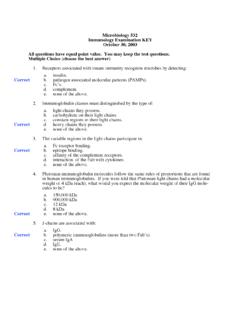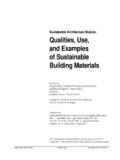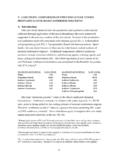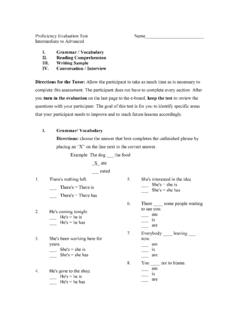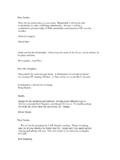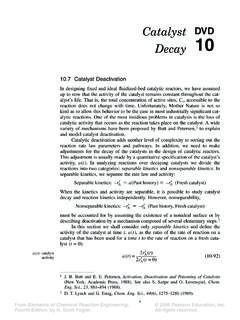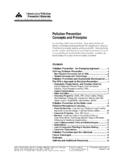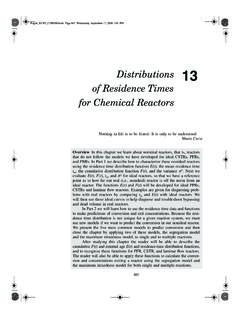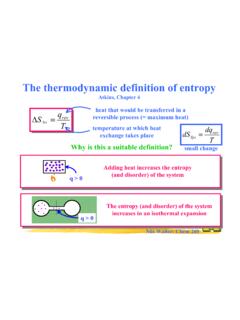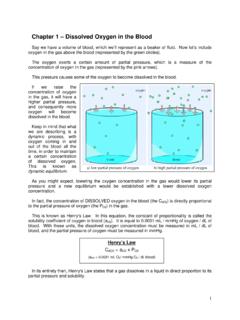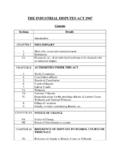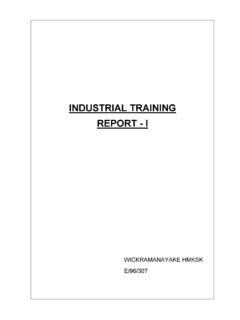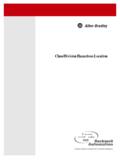Transcription of Industrial Ecology: An Introduction
1 Pollution Prevention and Industrial ecology NATIONAL POLLUTION PREVENTION CENTER FOR HIGHER EDUCATION. Industrial ecology : An Introduction By Andy Garner, NPPC Research Assistant; and Gregory A. Keoleian, , Assistant Research Scientist, University of Michigan School of Natural Resources and Environment, and NPPC Research Manager Background .. 2 Appendix A: Industrial Symbiosis at Kalundborg .. 28. Industrial ecology : Toward a Definition .. 3 Appendix B: Selected Definitions .. 31. Historical 3. Defining Industrial ecology .. 4 List of Tables Teaching Industrial ecology .. 4 Table 1: Organizational Hierarchies .. 2. Industrial ecology as a Field of ecology .. 5 Table 2: Worldwide Atmospheric Emissions of Goals of Industrial ecology .. 5 Trace Metals (Thousand Tons/Year) .. 9. Sustainable Use of Resources .. 6 Table 3: Global Flows of Selected Materials.
2 9. Ecological and Human Health .. 6 Table 4: Resources Used in Automaking .. 10. Environmental 6 Table 5: General Difficulties and Limitations of Key Concepts of Industrial ecology .. 6 the LCA Methodology .. 20. Systems Analysis .. 6 Table 7: Issues to Consider When Developing Environmental Requirements .. 23. Material & Energy Flows & Transformations .. 6. Table 8: Strategies for Meeting Environmental Multidisciplinary Approach .. 10. Requirements .. 24. Analogies to Natural Systems .. 10. Table 9: Definitions of Accounting and Capital Open- vs. Closed-Loop Systems .. 11 Budgeting Terms Relevant to LCD .. 25. Strategies for Environmental Impact Reduction: List of Figures Industrial ecology as a Potential Umbrella Figure 1: The Kalundborg Park .. 3. for Sustainable Development Strategies .. 12 Figure 2: World Extraction, Use, and Disposal System Tools to Support Industrial ecology .
3 12 of Lead, 1990 (thousand tons) .. 7. Life Cycle Assessment .. 12 Figure 3: Flow of Platinum Through Various Product Components .. 13 Systems .. 8. Methodology .. 13 Figure 4: Arsenic Pathways in , 1975.. 8. Applications .. 20 Figure 5: System Types .. 11. Difficulties .. 20 Figure 6: Technical Framework for LCA .. 13. Life Cycle Design & Design for Environment .. 21 Figure 7: The Product Life Cycle System .. 14. Needs Analysis .. 21 Figure 9: Flow Diagram Template .. 15. Design Requirements .. 21 Figure 8: Process Flow Diagram .. 15. Design Strategies .. 24. Figure 10: Checklist of Criteria With Worksheet .. 16. Design Evaluation .. 25. Figure 11: Detailed System Flow Diagram for Bar Soap .. 18. Future Needs .. 26 Figure 12: Impact Assessment Conceptual Framework .. 19. Further Information .. 26 Figure 13: Life Cycle Design.
4 22. Endnotes .. 27 Figure 14: Requirements Matrices .. 23. National Pollution Prevention Center for Higher Education University of Michigan May be reproduced Introduction 1. Dana Building, 430 East University, Ann Arbor MI 48109-1115 freely for non-commercial November 1995. fax ~nppcpub educational purposes. This portion of the Industrial ecology compendium Environmental problems are systemic and thus require provides an overview of the subject and offers guidance a systems approach so that the connections between in- on how one may teach it. Other educational resources dustrial practices/human activities and environmental/. are also emerging. Industrial ecology (Thomas Graedel ecological processes can be more readily recognized. and Braden Allenby; New York: Prentice Hall, 1994), A systems approach provides a holistic view of envi- the first university textbook on the topic, provides a ronmental problems, making them easier to identify well-organized Introduction and overview to Industrial and solve; it can highlight the need for and advantages ecology as a field of study.
5 Another good textbook is of achieving sustainability. Table 1 depicts hierarchies Pollution Prevention: Homework and Design Problems for of political, social, Industrial , and ecological systems. Engineering Curricula (David T. Allen, N. Bakshani, and Industrial ecology studies the interaction between dif- Kirsten Sinclair Rosselot; Los Angeles: American Insti- ferent Industrial systems as well as between Industrial tute of Chemical Engineers, American Insttute for Pol- systems and ecological systems. The focus of study lution Prevention, and the Center for Waste Reduction can be at different system levels. Technologies, 1993). Both serve as excellent sources of One goal of Industrial ecology is to change the linear both qualitative and quantitative problems that could nature of our Industrial system, where raw materials be used to enhance the teaching of Industrial ecology are used and products, by-products, and wastes are concepts.
6 Other sources of information are noted else- produced, to a cyclical system where the wastes are where in this Introduction and in the accompanying reused as energy or raw materials for another product Industrial ecology Resource List.. or process. The Kalundborg, Denmark, eco- Industrial park represents an attempt to create a highly integrated Background Industrial system that optimizes the use of byproducts and minimizes the waste that that leaves the system. The development of Industrial ecology is an attempt to Figure 1 shows the symbiotic nature of the Kalundborg provide a new conceptual framework for understanding park (see Appendix A for a more complete description). the impacts of Industrial systems on the environment (see the Overview of Environmental Problems section Fundamental to Industrial ecology is identifying and of this compendium).
7 This new framework serves to tracing flows of energy and materials through various identify and then implement strategies to reduce the systems. This concept, sometimes referred to as indus- environmental impacts of products and processes trial metabolism, can be utilized to follow material and associated with Industrial systems, with an ultimate energy flows, transformations, and dissipation in the goal of sustainable development. Industrial system as well as into natural The mass balancing of these flows and transformations Industrial ecology is the study of the physical, chemical, can help to identify their negative impacts on natural and biological interactions and interrelationships both ecosystems. By quantifying resource inputs and the within and between Industrial and ecological systems. generation of residuals and their fate, industry and Additionally, some researchers feel that Industrial ecol- other stakeholders can attempt to minimize the environ- ogy involves identifying and implementing strategies mental burdens and optimize the resource efficiency of for Industrial systems to more closely emulate harmo- material and energy use within the Industrial system.
8 Nious, sustainable, ecological ecosystems. 1. TABLE 1: ORGANIZATIONAL HIERARCHIES. Political Social Industrial Industrial Ecological Entities Organizations Organizations Systems Systems UNEP World population ISO Global human material Ecosphere (EPA, DOE) Cultures Trade associations and energy flows Biosphere State of Michigan Communities Corporations Sectors ( , transpor- Biogeographical (Michigan DEQ) Product systems Divisions tation or health care) region Washtenaw County Households Product develop- Corporations/institutions Biome landscape City of Ann Arbor Individuals/ ment teams Product systems Ecosystem Individual Voter Consumbers Individuals Life cycle stages/unit steps Organism Source: Keoleian et al., Life Cycle Design Framework and Demonstration Projects (Cincinnati: EPA Risk Reduction Engineering Lab, 1995), 17.
9 2 Introduction November 1995. FIGURE 1: THE KALUNDBORG PARK. Industrial ecology is an emerging field. There is much furthered this work in their seminal book Limits to discussion and debate over its definition as well as its Growth (New York: Signet, 1972). Using systems practicality. Questions remain concerning how it over- analysis, they simulated the trends of environmental laps with and differs from other more established fields degradation in the world, highlighting the unsustainable of study. It is still uncertain whether Industrial ecology course of the then-current Industrial system. warrants being considered its own field or should be incorporated into other disciplines. This mirrors the In 1989, Robert Ayres developed the concept of challenge in teaching it. Industrial ecology can be taught Industrial metabolism: the use of materials and energy as a separate, semester-long course or incorporated into by industry and the way these materials flow through existing courses.
10 It is foreseeable that more colleges Industrial systems and are transformed and then and universities will begin to initiate educational and dissipated as By tracing material and energy research programs in Industrial ecology . flows and performing mass balances, one could identify inefficient products and processes that result in indus- trial waste and pollution, as well as determine steps to Industrial ecology : Toward a Definition reduce them. Robert Frosch and Nicholas Gallopoulos, in their important article Strategies for Manufacturing . Historical Development (Scientific American 261; September 1989, 144 152), Industrial ecology is rooted in systems analysis and developed the concept of Industrial ecosystems, which is a higher level systems approach to framing the inter- led to the term Industrial ecology . Their ideal Industrial action between Industrial systems and natural systems.
